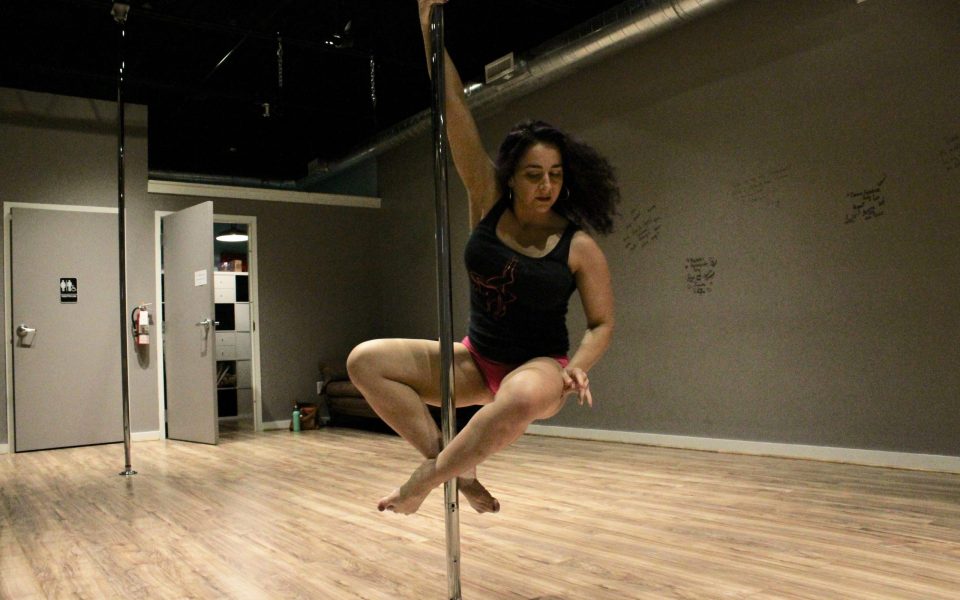Nikki Craven grips the pole with both of her hands and lifts her muscular thighs up into the air. Still suspended, she slowly wraps her legs around the pole and twirls as gravity gently brings her snaking body to the floor. She turns around, now facing the mirrored wall and rocks her back and hips against the pole and sensually runs her fingers through her hair before reaching up and regripping the pole above her head. With one swift motion she hoists her body up and flips until she’s completely upside down, still hugging the chrome pole like a magnet. She grasps it using the pockets behind her knees and lets her hands go. Her curly purple hair hangs loose as she dangles freely for a few seconds before she relaxes her legs muscles and slithers back down.
Craven, the owner and one of the instructors at Descending Angels dance studio in downtown Greensboro, has been pole-dancing for 13 years and running the studio for the last 10.
“It’s pretty addicting,” says Craven, who picked up the artform as a way to recover from spinal fusion surgery, a result of years of living with scoliosis.
“It was too painful to do even mundane things like pick up milk,” she says. “Nothing helped like pole; it improved my physical and mental health.”
While many may still associate pole dancing with strip clubs, the roots of using a pole for sport or art actually dates back hundreds of years, according to verticalwise.com, a website focused on aerial and pole dancing. It’s related to ancient sports like mallakhamba in India, where gymnasts perform gravity-defying feats using a vertical pole, and pole climbing in China. It wasn’t until the late 1900s that it started being used as a sensual act in circuses, then in burlesque shows and, eventually, strip clubs.
Despite any of the negative connotations that the art form may have, Craven hopes that her studio, which also offers classes in sensual floorwork, aerial dance and ab and butt workouts, helps people feel empowered and shows them what their bodies can do.
“I still hear from students that I had several years ago,” Craven says. “They say how it’s changed their body image and self-confidence.”
She says that while most of the students in her classes are femme women, she encourages people from all walks of life, genders, orientations, age ranges and body types to come take classes. She notes how pole dancing can help those with mental or physical health issues and mentioned how it even helped one woman regain confidence in herself after a divorce.
And for those that still look down on the art form, Craven has some choice words.
“I just don’t give a rat’s ass,” she says. “I don’t see things as simply bad because it’s sexual. It’s a way to express ourselves. No one has any business telling us what to do with our own bodies.”
Heather Carroll, who has been coming to Descending Angels for three months now, is one of the studio’s most avid students and an example of someone whose life has been changed by the art.
“I had a really hard time getting back into exercising consistently since my son was born five years ago,” says Carroll, who decided to try pole dancing after seeing an ad on Facebook. “This is the first thing that I’ve been able to stick with and really enjoy.”
She even ordered a pole through the studio for her home and plans to install it in her bedroom.
“I’ve always had chronic aches and pains and I feel better now than I have in a long time,” Carroll says.
She says that she plans on continuing her classes so she can eventually do inversions like Craven does.
“I have a doctor’s appointment coming up and it’ll be the first time that I’m seeing my doctor since I started working out here,” says Craven, smiling, “I’m really excited for him to see my level of health and fitness now versus three months ago.”
Join the First Amendment Society, a membership that goes directly to funding TCB‘s newsroom.
We believe that reporting can save the world.
The TCB First Amendment Society recognizes the vital role of a free, unfettered press with a bundling of local experiences designed to build community, and unique engagements with our newsroom that will help you understand, and shape, local journalism’s critical role in uplifting the people in our cities.
All revenue goes directly into the newsroom as reporters’ salaries and freelance commissions.


Leave a Reply